SIT151 - Exploring the Actions in Games Concept: A Game Design Report
VerifiedAdded on 2023/06/14
|7
|949
|369
Report
AI Summary
This report delves into the fundamental concept of actions in games, examining the various on-screen activities performed by both playable and non-playable characters. It traces the history of this concept from early arcade games with limited directional movements to modern games offering a wide array of actions enabled by technologies like motion capture. Key terminologies such as gamer control and motion capture are explained. The report uses FIFA 18 as a case study, illustrating how motion capture technology enhances the realism of in-game character actions by replicating real-world footballer movements. The document includes screenshots demonstrating the motion capture process and the resemblance between in-game characters and their real-world counterparts. This report was written for SIT151.
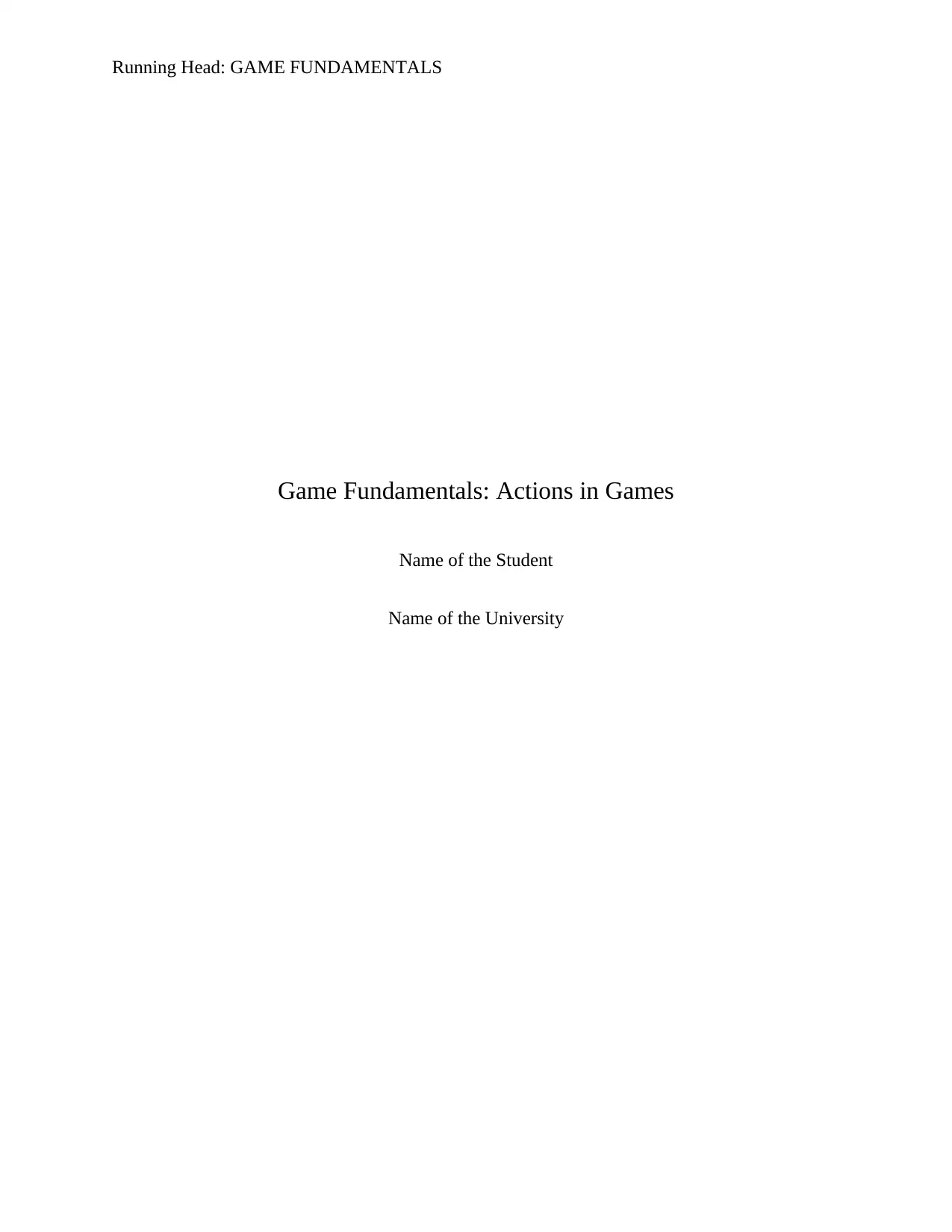
Running Head: GAME FUNDAMENTALS
Game Fundamentals: Actions in Games
Name of the Student
Name of the University
Game Fundamentals: Actions in Games
Name of the Student
Name of the University
Paraphrase This Document
Need a fresh take? Get an instant paraphrase of this document with our AI Paraphraser

1GAME FUNDAMENTALS
Introduction to the Concept
The concept of action in games refers to the various on-screen actions performed by the
playable and non-playable characters inside a video game. The actions of the playable characters
are controlled by the player using controller devices like keyboard or joystick whereas the
actions of the unplayable characters are controlled by predefined programs (Arnab et al., 2015).
The first action in games was simply one direction running movement whereas in the latest
games, the characters are able to perform a wide variety of movements as well as move in all
directions (360°).
History of the Concept
Although the concept of video games was developed as early as in 1950s, the concept of
action was developed much later when arcade games were flourishing in the gaming industry.
The initial games where player actions were used were Super Mario, Donkey Kong, Dangerous
Dave and others.
Figure 1: Game Screenshots of Dave, Kong and Mario (Left to Right)
(Source: Lameras et al., 2017)
Introduction to the Concept
The concept of action in games refers to the various on-screen actions performed by the
playable and non-playable characters inside a video game. The actions of the playable characters
are controlled by the player using controller devices like keyboard or joystick whereas the
actions of the unplayable characters are controlled by predefined programs (Arnab et al., 2015).
The first action in games was simply one direction running movement whereas in the latest
games, the characters are able to perform a wide variety of movements as well as move in all
directions (360°).
History of the Concept
Although the concept of video games was developed as early as in 1950s, the concept of
action was developed much later when arcade games were flourishing in the gaming industry.
The initial games where player actions were used were Super Mario, Donkey Kong, Dangerous
Dave and others.
Figure 1: Game Screenshots of Dave, Kong and Mario (Left to Right)
(Source: Lameras et al., 2017)
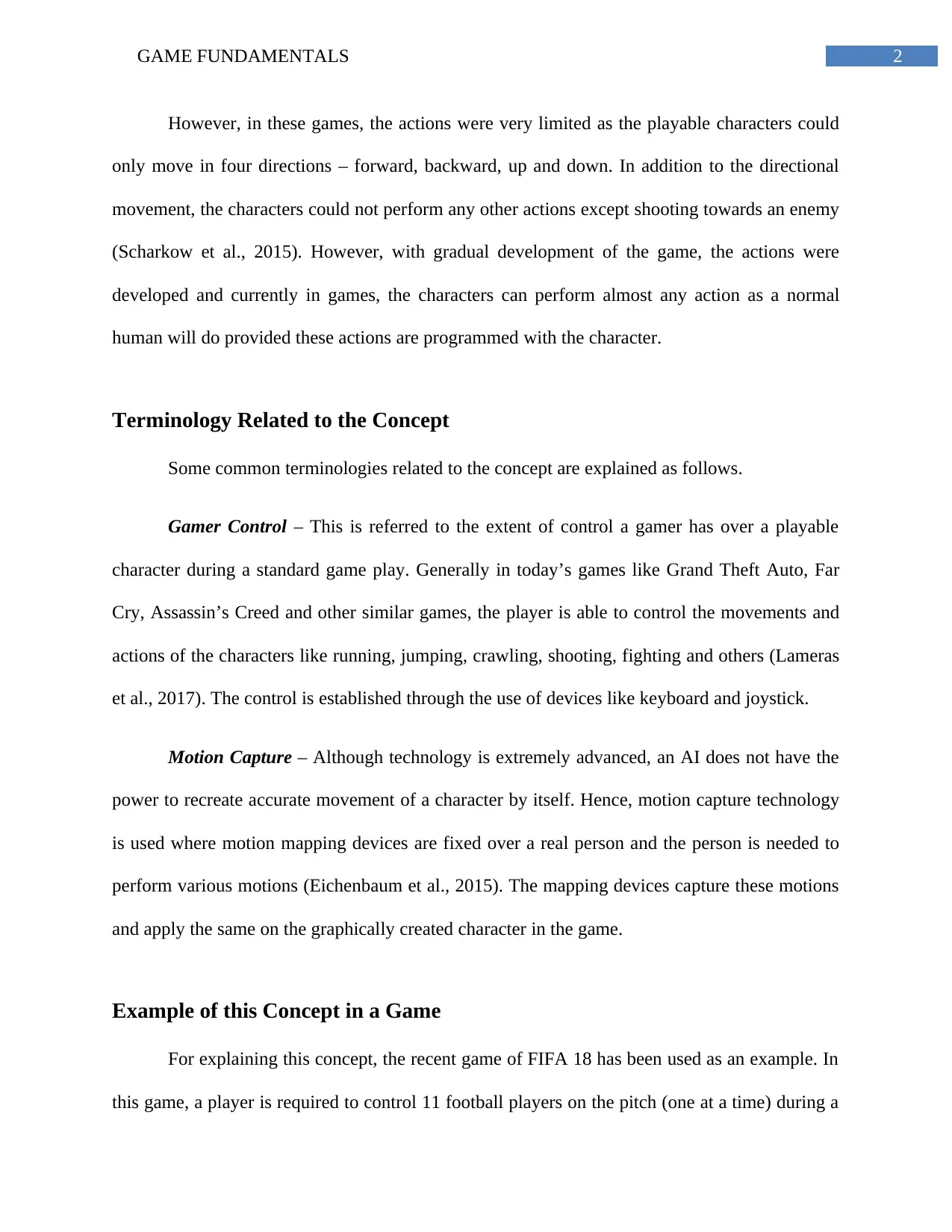
2GAME FUNDAMENTALS
However, in these games, the actions were very limited as the playable characters could
only move in four directions – forward, backward, up and down. In addition to the directional
movement, the characters could not perform any other actions except shooting towards an enemy
(Scharkow et al., 2015). However, with gradual development of the game, the actions were
developed and currently in games, the characters can perform almost any action as a normal
human will do provided these actions are programmed with the character.
Terminology Related to the Concept
Some common terminologies related to the concept are explained as follows.
Gamer Control – This is referred to the extent of control a gamer has over a playable
character during a standard game play. Generally in today’s games like Grand Theft Auto, Far
Cry, Assassin’s Creed and other similar games, the player is able to control the movements and
actions of the characters like running, jumping, crawling, shooting, fighting and others (Lameras
et al., 2017). The control is established through the use of devices like keyboard and joystick.
Motion Capture – Although technology is extremely advanced, an AI does not have the
power to recreate accurate movement of a character by itself. Hence, motion capture technology
is used where motion mapping devices are fixed over a real person and the person is needed to
perform various motions (Eichenbaum et al., 2015). The mapping devices capture these motions
and apply the same on the graphically created character in the game.
Example of this Concept in a Game
For explaining this concept, the recent game of FIFA 18 has been used as an example. In
this game, a player is required to control 11 football players on the pitch (one at a time) during a
However, in these games, the actions were very limited as the playable characters could
only move in four directions – forward, backward, up and down. In addition to the directional
movement, the characters could not perform any other actions except shooting towards an enemy
(Scharkow et al., 2015). However, with gradual development of the game, the actions were
developed and currently in games, the characters can perform almost any action as a normal
human will do provided these actions are programmed with the character.
Terminology Related to the Concept
Some common terminologies related to the concept are explained as follows.
Gamer Control – This is referred to the extent of control a gamer has over a playable
character during a standard game play. Generally in today’s games like Grand Theft Auto, Far
Cry, Assassin’s Creed and other similar games, the player is able to control the movements and
actions of the characters like running, jumping, crawling, shooting, fighting and others (Lameras
et al., 2017). The control is established through the use of devices like keyboard and joystick.
Motion Capture – Although technology is extremely advanced, an AI does not have the
power to recreate accurate movement of a character by itself. Hence, motion capture technology
is used where motion mapping devices are fixed over a real person and the person is needed to
perform various motions (Eichenbaum et al., 2015). The mapping devices capture these motions
and apply the same on the graphically created character in the game.
Example of this Concept in a Game
For explaining this concept, the recent game of FIFA 18 has been used as an example. In
this game, a player is required to control 11 football players on the pitch (one at a time) during a
⊘ This is a preview!⊘
Do you want full access?
Subscribe today to unlock all pages.

Trusted by 1+ million students worldwide
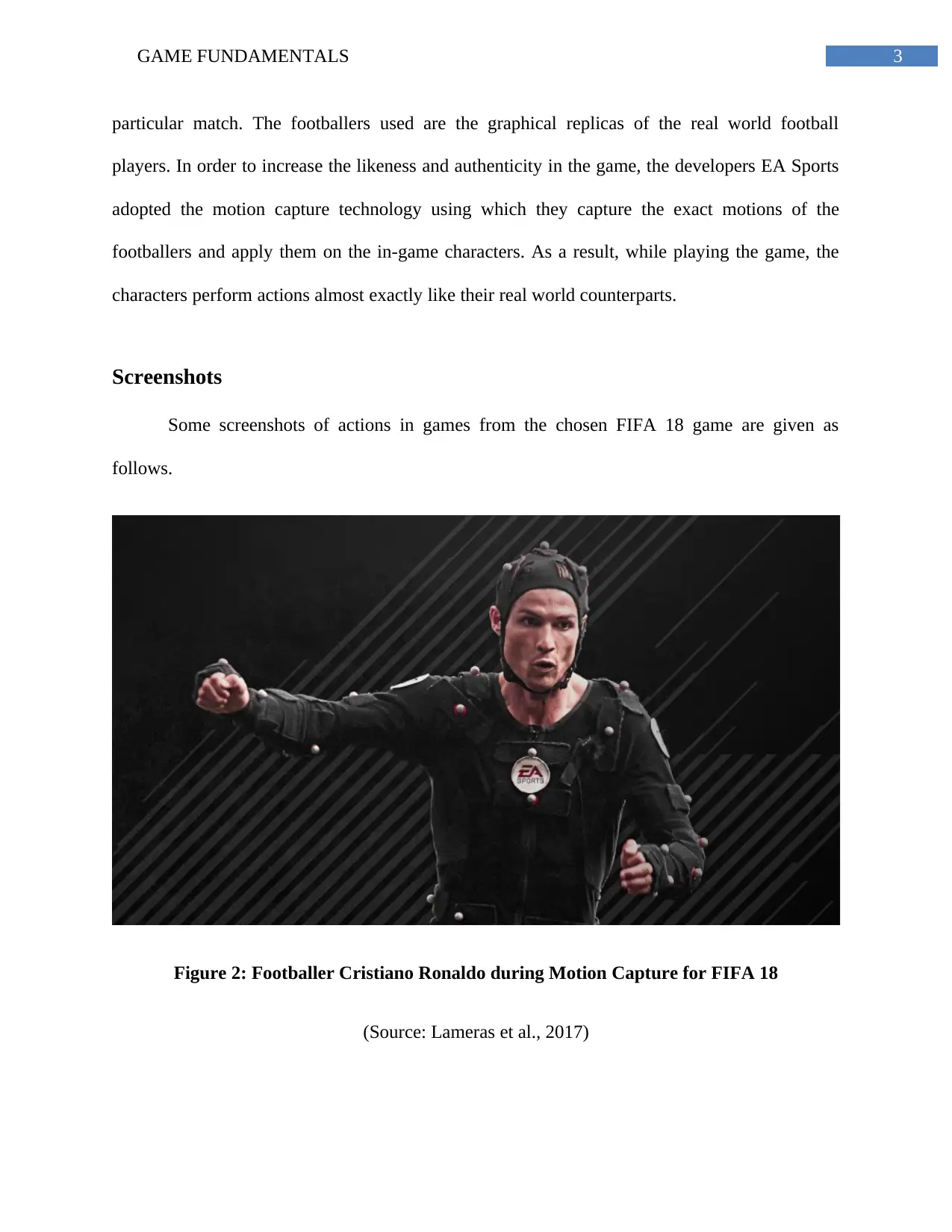
3GAME FUNDAMENTALS
particular match. The footballers used are the graphical replicas of the real world football
players. In order to increase the likeness and authenticity in the game, the developers EA Sports
adopted the motion capture technology using which they capture the exact motions of the
footballers and apply them on the in-game characters. As a result, while playing the game, the
characters perform actions almost exactly like their real world counterparts.
Screenshots
Some screenshots of actions in games from the chosen FIFA 18 game are given as
follows.
Figure 2: Footballer Cristiano Ronaldo during Motion Capture for FIFA 18
(Source: Lameras et al., 2017)
particular match. The footballers used are the graphical replicas of the real world football
players. In order to increase the likeness and authenticity in the game, the developers EA Sports
adopted the motion capture technology using which they capture the exact motions of the
footballers and apply them on the in-game characters. As a result, while playing the game, the
characters perform actions almost exactly like their real world counterparts.
Screenshots
Some screenshots of actions in games from the chosen FIFA 18 game are given as
follows.
Figure 2: Footballer Cristiano Ronaldo during Motion Capture for FIFA 18
(Source: Lameras et al., 2017)
Paraphrase This Document
Need a fresh take? Get an instant paraphrase of this document with our AI Paraphraser

4GAME FUNDAMENTALS
Figure 3: A Footballer Performing Various Actions during Motion Capture
(Source: Lameras et al., 2017)
Figure 3: A Footballer Performing Various Actions during Motion Capture
(Source: Lameras et al., 2017)
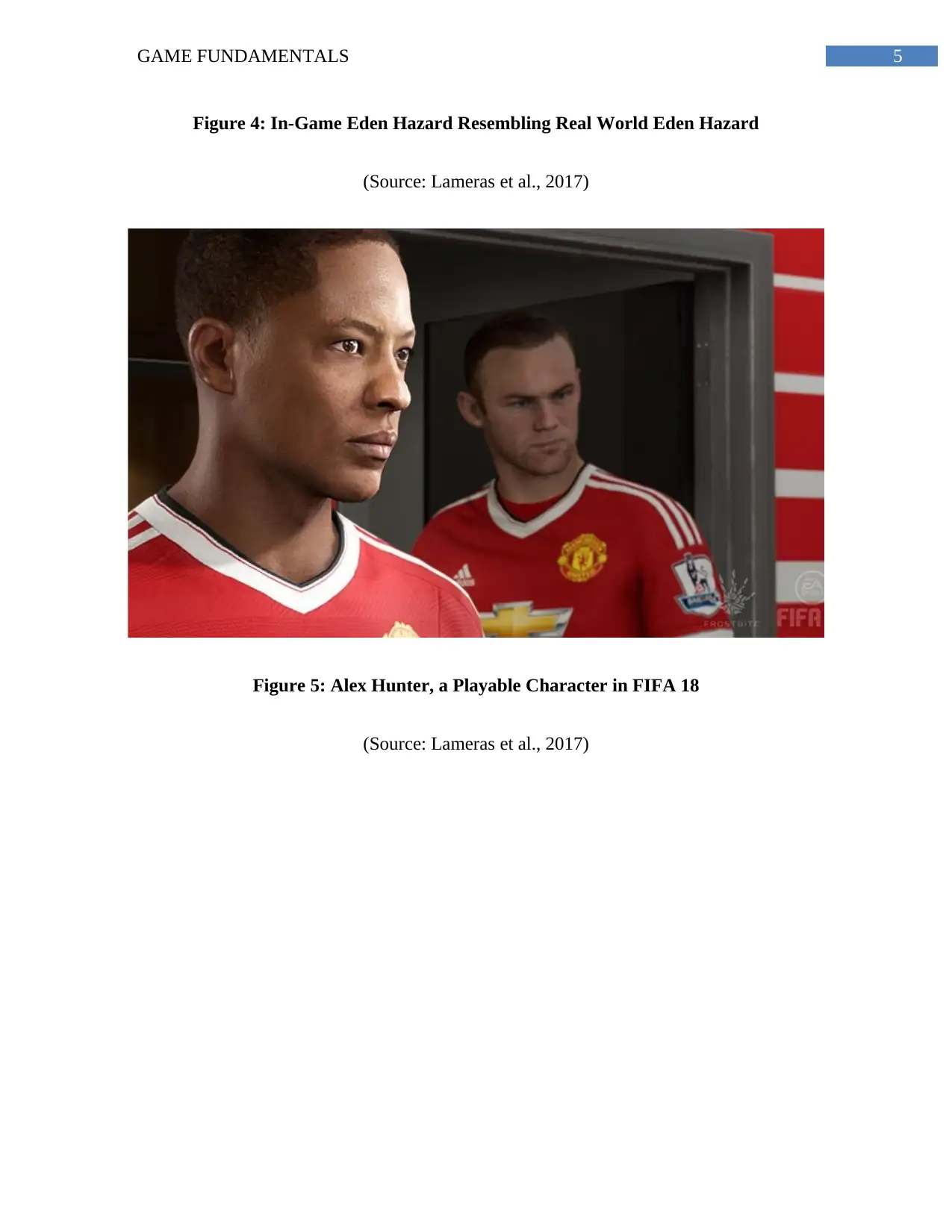
5GAME FUNDAMENTALS
Figure 4: In-Game Eden Hazard Resembling Real World Eden Hazard
(Source: Lameras et al., 2017)
Figure 5: Alex Hunter, a Playable Character in FIFA 18
(Source: Lameras et al., 2017)
Figure 4: In-Game Eden Hazard Resembling Real World Eden Hazard
(Source: Lameras et al., 2017)
Figure 5: Alex Hunter, a Playable Character in FIFA 18
(Source: Lameras et al., 2017)
⊘ This is a preview!⊘
Do you want full access?
Subscribe today to unlock all pages.

Trusted by 1+ million students worldwide
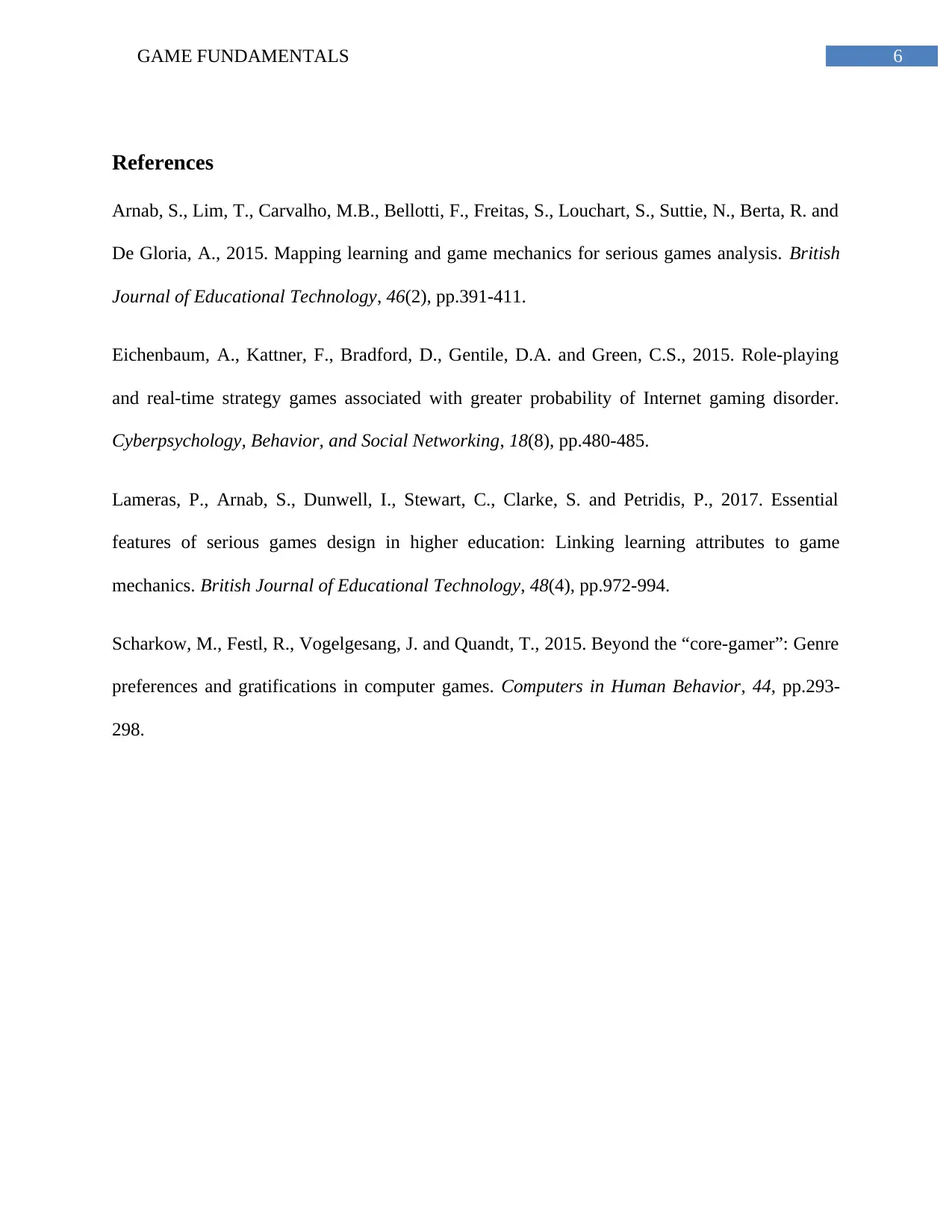
6GAME FUNDAMENTALS
References
Arnab, S., Lim, T., Carvalho, M.B., Bellotti, F., Freitas, S., Louchart, S., Suttie, N., Berta, R. and
De Gloria, A., 2015. Mapping learning and game mechanics for serious games analysis. British
Journal of Educational Technology, 46(2), pp.391-411.
Eichenbaum, A., Kattner, F., Bradford, D., Gentile, D.A. and Green, C.S., 2015. Role-playing
and real-time strategy games associated with greater probability of Internet gaming disorder.
Cyberpsychology, Behavior, and Social Networking, 18(8), pp.480-485.
Lameras, P., Arnab, S., Dunwell, I., Stewart, C., Clarke, S. and Petridis, P., 2017. Essential
features of serious games design in higher education: Linking learning attributes to game
mechanics. British Journal of Educational Technology, 48(4), pp.972-994.
Scharkow, M., Festl, R., Vogelgesang, J. and Quandt, T., 2015. Beyond the “core-gamer”: Genre
preferences and gratifications in computer games. Computers in Human Behavior, 44, pp.293-
298.
References
Arnab, S., Lim, T., Carvalho, M.B., Bellotti, F., Freitas, S., Louchart, S., Suttie, N., Berta, R. and
De Gloria, A., 2015. Mapping learning and game mechanics for serious games analysis. British
Journal of Educational Technology, 46(2), pp.391-411.
Eichenbaum, A., Kattner, F., Bradford, D., Gentile, D.A. and Green, C.S., 2015. Role-playing
and real-time strategy games associated with greater probability of Internet gaming disorder.
Cyberpsychology, Behavior, and Social Networking, 18(8), pp.480-485.
Lameras, P., Arnab, S., Dunwell, I., Stewart, C., Clarke, S. and Petridis, P., 2017. Essential
features of serious games design in higher education: Linking learning attributes to game
mechanics. British Journal of Educational Technology, 48(4), pp.972-994.
Scharkow, M., Festl, R., Vogelgesang, J. and Quandt, T., 2015. Beyond the “core-gamer”: Genre
preferences and gratifications in computer games. Computers in Human Behavior, 44, pp.293-
298.
1 out of 7
Your All-in-One AI-Powered Toolkit for Academic Success.
+13062052269
info@desklib.com
Available 24*7 on WhatsApp / Email
![[object Object]](/_next/static/media/star-bottom.7253800d.svg)
Unlock your academic potential
Copyright © 2020–2025 A2Z Services. All Rights Reserved. Developed and managed by ZUCOL.